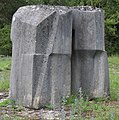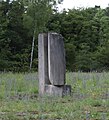Sculpture symposium Kaisersteinbruch
The Kaisersteinbruch sculpture symposium near Gaubüttelbrunn near Kirchheim in Lower Franconia was the first international sculpture symposium in the Federal Republic with sculptors from Germany, Austria, Yugoslavia, Israel, the USA and Japan. In this symposium, which took place from June 12 to September 15, 1961, 15 sculptures were created by ten artists.
This form of sculpture goes back to the first European sculpture symposium , the St. Margarethen Sculpture Symposium , from 1959 in Sankt Margarethen in Burgenland in Austria , to which more than 150 symposia still refer today.
Symposium
The Berlin sculptors Herbert Baumann, Erich Reischke and Joachim-Fritz Schultze-Bansen began with the support of their sculptor professors Karl Hartung and Alexander Gonda with the organization of sculpture symposia in Germany. Hellmuth Metzing , managing director of the stonemason company Zeidler & Wimmel , owner of the Gaubüttelbronn Kaisersteinbruch, was positive about this idea and sponsored the symposium. In Gaubüttelbrunn, stone sculptors from different countries and nations worked together and created large sculptures from Kirchheim shell limestone . They exchanged views on their different artistic experiences and techniques, their ideas and plans. When the construction of the Berlin Wall began on August 13, 1961, some stone sculptors decided to go there and upon their return it was agreed that they would hold another symposium near the Berlin Wall in October 1961 . This idea was realized and sculpture symposia took place in the years 1961–1963 in Berlin-Tiergarten, which were also called symposia for building the wall.
This approach corresponded to the concept of the European Sculpture Symposia: in addition to the exchange of experiences with colleagues from all over the world - who later, following the example of the sculptor Karl Prantls , the initiator of the European Sculpture Symposia, often organize similar meetings in their home countries - there was always a political intention Foreground. Prantl fought against the “Iron Curtain” from the start, as well as against the Berlin Wall . As early as 1959, the organizers of the first European sculpture symposium wrote a manifesto in which they announced the political and socio-political aspirations of their ideas, namely to give a signal for international understanding through their cross-border community.
In the course of the symposium, 15 sculptures were created, three of which are in other locations. These are the works of Yasuo Mizui, Joseph Henry Lonas and Herbert Baumann. The symposium participant Jakob Savinšek died in the course of the symposium on August 17, 1961, so his second sculpture remained unfinished.
Attendees
The ten sculptors in the Gaubütteler Muschelkalk quarry who created stone sculptures from this shell limestone were
- Herbert Baumann , Berlin (sculpture in Eindhoven)
- Joachim-Fritz Schultze-Bansen , Berlin
- Joseph Henry Lonas , USA (whereabouts of the sculpture unknown)
- Menashe Kadishman , Israel
- Jakob Savinšek , Yugoslavia (two sculptures, one remained unfinished)
- Karl Prantl , Austria (two sculptures in Gaubüttelbronn)
- Janez Lenassi , Yugoslavia
- Erich Reischke , Berlin
- Moshé Schwartz , Israel
- Yasuo Mizui , Japan (whereabouts of the sculpture unknown)
Photo gallery
Herbert Baumann's sun disk (not in Gaubüttelbrunn, but today in Eindhoven )
Kaisersteinbruch
The symposium took place in the Kaisersteinbruch and this name obviously goes back to a Kaisersteinbruch stock corporation from 1912. This stock corporation was the owner of the site before Zeidler & Wimmel took over the quarry. Today the quarry is owned by Winfried Engert. The quarry entered the list of Bavarian geotopes.
To mark the 50th anniversary of the symposium, an exhibition with photos of the sculptures provided by Karl Prantl's widow, a church service and guided tours of the former quarry area with the sculptures in Gaubüttelbrunn took place on September 11, 2011 as part of the Open Monument Day 2001 .
The stone sculptures are located on Bahnstraße at the exit of Gaubüttelbrunn and can be reached on foot in a forest via an approximately 300-meter-long forest path, in front of which there is a barrier. On the right hand side of the forest path there is a 1.30 meter high stone with two symbols, a goose and a moon.
literature
- Wolfgang Hartmann (Hrsg.): The sculpture symposium: Origin and development of a new form of collective and artistic work. Stuttgart 1988, ISBN 3-7757-0263-6
- Jutta Birgit Wortmann: Sculpture Symposia: Origin - Development - Change. Frankfurt am Main, 2006, ISBN 3-631-55273-4
- Zeidler & Wimmel (ed.): Building in natural stone. 200 years of Zeidler & Wimmel. Quarries, stonemasons, stone industry. P. 100 f. Bruckmann. Munich 1976 o.A.
Web links
Individual evidence
- ^ Jutta Wortmann: Sculpture Symposia: Origin - Development - Change . Pp. 133–135 (see literature)
- ↑ a b mobil.mainpost.de : Edmund Gumpert: Five parallels in one magical place , from June 23, 2011, accessed on July 2, 2011
- ^ Jutta Wortmann: Sculpture Symposia: Origin - Development - Change . P. 133
- ^ Zeidler & Wimmel: Building with natural stone. P. 100 (see literature)
- ↑ Tiroler Tageszeitung from October 29, 2003 . Retrieved August 22, 2010
- ^ Jutta Wortmann: Sculpture Symposia: Origin - Development - Change . Pp. 53-55
- ↑ a b mobil.mainpost.de : Edmund Gumpert: Gaubüttelbronn. Listed collection of monumental abstract sculptures for 50 years in the Kaisersteinbruch in Gaubüttelbrunn , from September 6, 2011, accessed on August 18, 2011
- ↑ Naturstein Hf .: 12/2011. P. 33 Online excerpt (PDF; 405 kB), accessed on August 18, 2012
- ^ Information about the Kaisersteinbruch-Aktiengesellschaft . Retrieved August 22, 2010
- ↑ Bavarian State Office for Environmental Protection: Geotope Cadastre Bavaria: Kaisersteinbruch near Gaubüttelbrunn (PDF; 241 kB). Retrieved August 22, 2010
Coordinates: 49 ° 38 '13.3 " N , 9 ° 52' 5.2" E










